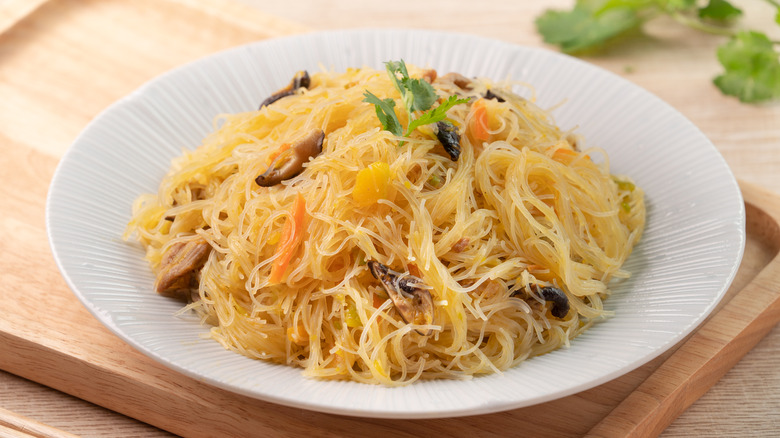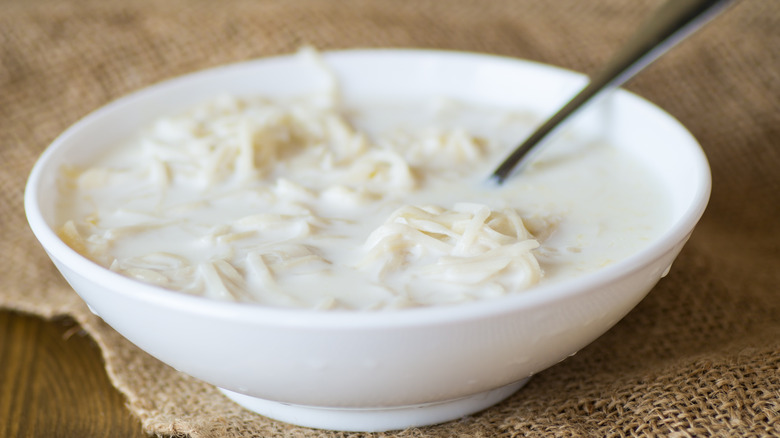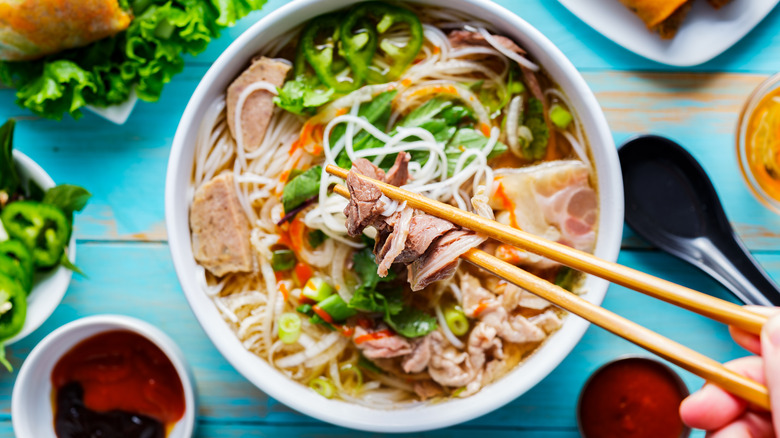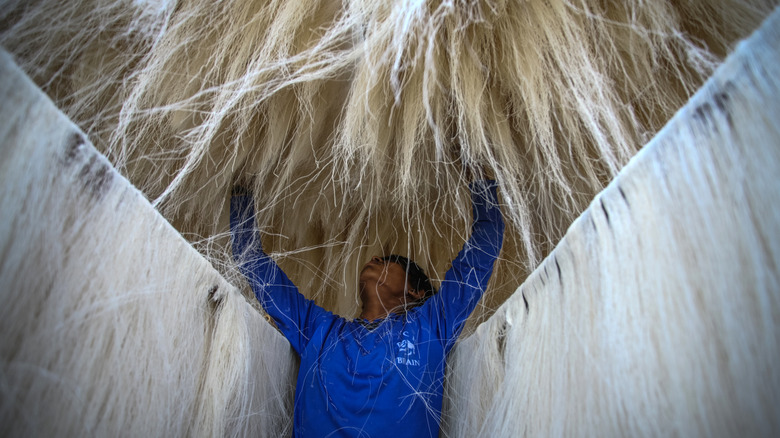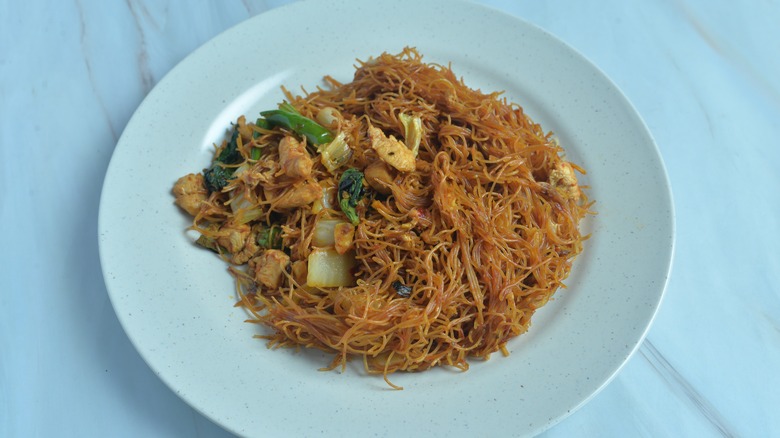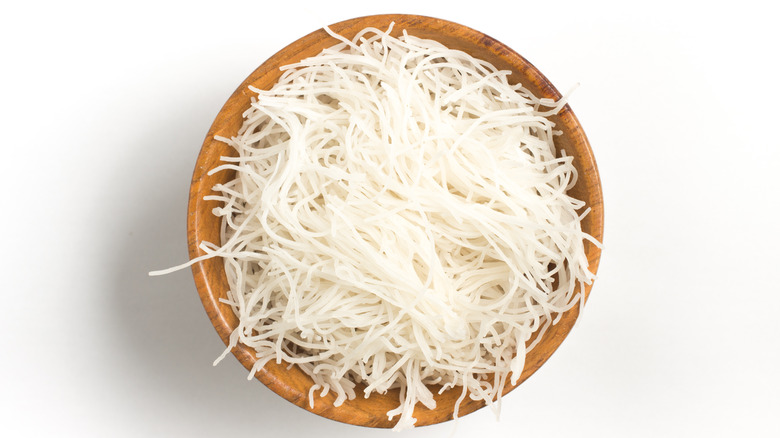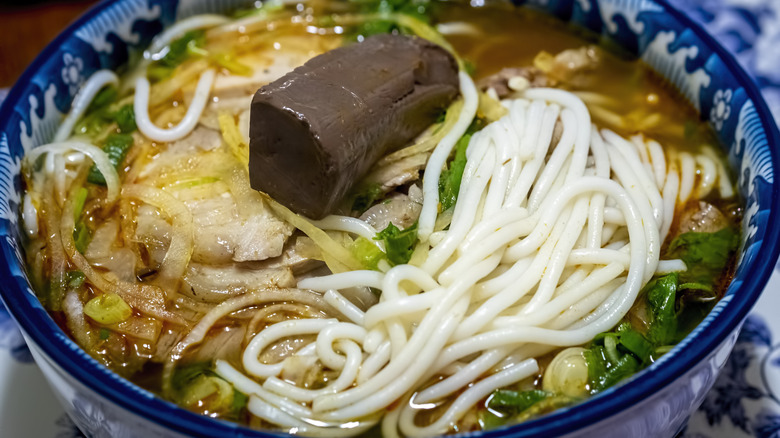What Makes Vermicelli Noodles Unique?
We may receive a commission on purchases made from links.
For many, vermicelli noodles often first call to mind clear and thin rice noodles that are a staple in Asian recipes. Others, especially those who speak Italian, may recognize the origin of the word. Literally translating as "little worms," vermicelli was used for a type of pasta from the 1660s to describe their worm likeness in shape.
Vermicelli as a word has evolved to signify any type of pasta that's made long and thin, whether it's made from wheat, egg, potatoes, sweet potatoes, rice, or other ingredients. (For the Brits though, it's taken on a completely different meaning and usually means thin and decorative chocolate sprinkles.) If you type vermicelli into the Amazon search bar, the results bring up Vietnamese rice noodles, Goya brand wheat Angel Hair vermicelli, garlic and olive oil from Pasta Roni, and Korean sweet potato noodles, amongst others.
What makes vermicelli unique is that it's a chameleon-type noodle that comes in many different shapes, forms, and flavors throughout a range of cuisines around the globe. Let's take a look at vermicelli around the world.
Italian origins of vermicelli
While vermicelli is often used to describe a thinner type of noodle, the original Italian vermicelli which originates from Campaniai is actually heartier and thicker than a classic spaghetti noodle. In Italy, vermicelli (vermecìidde) alla sangiuannìidde — usually made with tomatoes, garlic, anchovies, parsley, and chili pepper — is a dish that's eaten annually to celebrate the feast of San Giovanni that falls around the same time as the summer solstice.
But don't visit Italy expecting to find this Italian vermicelli dish up for offer on a menu: vermicelli alla sangiuannìidde is usually homemade and to the palatal preference of the chef, cooked more by feeling and out of convenience because it's made with simple ingredients.
Another variation of Italian vermicelli which involves tuna and anchovies is the vermicelli alla campolattaro, which was invented in the 19th century by a Neapolitan marquis. Pasta makers in Neapolitan of yesteryear were even referred to as "vermicellari," a word that dates back to 1571. One recipe from a 14th-century manuscript calls for wheat flour, eggs, almonds, cane sugar, spices, and salt — and could have been enjoyed as is or dressed up to be either sweet or savory.
Vermicelli in 18th and 19th-century America
Before the American Revolution kicked off in 1775, vermicelli had already made its way to America, most likely along with the European settlers that arrived in the country. In Hannah Glass's 1770 cookbook, "The Art of Cookery," it was made simply with egg yolks and flour. The recipe itself calls for the vermicelli to be cut "as thinly as possible." Another edition of her cookbook was printed in 1784 and includes a vermicelli pudding recipe, which is essentially a kugel.
Another early mention of vermicelli in the U.S. appears in the 1860 publication of "The Virginia Housewife," which includes a recipe for vermicelli that's made out of eggs and flour and dried out on tin sheets, to be used in soups. Soups in early American history that used vermicelli include milk soup, which is essentially heated-up salted milk with noodles. It's then flavored with egg yolks — or cinnamon and sugar, as a sweet alternative.
Vermicelli in Asian cuisine
Rice noodles, which originated way back during the Qin Dynasty more than thousands of years ago, are still immensely popular today in China, as well as Taiwan and Southeast Asian countries like Singapore and Vietnam. In Cantonese, rice noodles are called 米粉 or mi fen/mei fun, though there are quite a few types of vermicelli in Asian cuisine.
Vietnamese rice vermicelli is usually sold dried and is gluten-free, and is often used in stir-fries and soups, and even as filler for rice paper rolls. Thin and round, it's also called bun, sen mae, mai fun, bee hoon. However, not all Asian vermicelli is made with rice: there is also mung bean vermicelli, also known as cellophane or glass noodles, that has a transparent appearance. Other vermicelli noodles are made from potato starch — this can be an incredibly labor-intensive process. Other types of noodles like misua have a wheat base but are also thin. Misua is used in popular street food in Taiwan and combines oysters and vermicelli ("orh ah mee sua" in Mandarin translates to oyster vermicelli).
Vermicelli in Indian cuisine
Across India, vermicelli goes by a variety of local names: shavige, semiya, sevalu, and seviyan are just a few. Like in Asian cuisine, Indian vermicelli can be made with rice or wheat flour — and in South India, the food is often enjoyed during breakfast. One typical South Indian vermicelli breakfast dish is Semiya Upma, which contains a mixture of vermicelli and vegetables. A similar dish from North India is called the Namkeen Seviyan, which literally translates to savory vermicelli. On the sweet front, Indian cuisine has a sweet vermicelli dish: Seviyan Kheer, or vermicelli pudding. It uses ghee, rice vermicelli noodles, milk, spices, and a sweetener.
As evidenced by this brief vermicelli world tour, these noodles are singular for their versatile nature. They're usually thin but sometimes thick, are savory or sweet, can be made up of starches made from wheat, rice, root vegetables, or even beans — and most importantly — are found in both Eastern and Western cuisines.
What vermicelli tastes like
Since a wide variety of noodles can go by the name of vermicelli, the taste largely depends on the type of vermicelli you're dealing with. Classic Italian vermicelli tastes similar to other wheat pasta made of semolina flour — it's one of many types of flours that have gluten — and will have a slightly stronger taste if made out of whole wheat.
Rice vermicelli has a more neutral flavor, acting more as a vehicle for other ingredients it is served with that soak up flavors. In Indian cuisine, sweet vermicelli made out of rice flavor tastes like rice pudding when eaten with milk, nuts, and cream. Vermicelli used in soups like pho will taste like the broth, and the noodles made in a stir-fry will similarity taste of whatever spices and aromatics are used in the dish.
Rice noodle vermicelli by itself has nearly no flavor, but the texture is a bit chewier than wheat pasta. Finally, while the dried noodles keep for a fairly long time, if they start to give off any sort of sour or musty smell, it's time to toss the dried vermicelli out.
Health benefits of vermicelli
Just as the taste of vermicelli varies depending on the type, the nutritional value and health benefits differ in relation to the noodle base. Whole wheat vermicelli is better for maintaining sugar levels while still providing a carbohydrate energy boost.
Rice-based vermicelli is gluten-free, which makes it a great choice for those with gluten sensitivities, and is also low in sodium, fat-free, and cholesterol-free. Other benefits of rice vermicelli noodles include a rich source of manganese and phosphorus, minerals that help with inflammation reduction and bone health, and selenium, an antioxidant that may prevent or delay some types of cell damage.
Vermicelli made from sweet potato is also lower in calories (but provides no protein) than traditional pasta noodles, while serving up potassium, magnesium, iron, and vitamin A. Generally, vermicelli isn't the food to rely on for your daily dose of vitamins though. It will, however, bring the health benefits of any carbohydrate: lots of energy, little fat, and zero cholesterol.
Where to buy vermicelli
Most major grocery stores like Whole Foods, Trader Joe's, and Walmart will carry various types of vermicelli: egg vermicelli, Thai wheat noodles, Italian vermicelli noodles, and Thai vermicelli noodles. Vermicelli is also easy to find and purchase online — Amazon carries a wide variety of vermicelli noodles, from dried Vietnamese rice noodles to angel hair vermicelli to bean vermicelli.
For those with a little bit of extra time on their hands, making your own homemade rice vermicelli is possible with rice flour, water, oil, tapioca flour, salt, and xanthan gum. If you have an entire day to make your own vermicelli, check out this old-school, traditional way of hand-making potato-based vermicelli on TikTok.
It captures the time-intensive and laborious process of washing and scrubbing potatoes, chopping and dicing them, juicing them through a stone mill, straining the juice, waiting for the potato starch to settle and dry, mixing the starch with water to make a dough, straining said dough through a strainer with holes into hot water to make the noodles, removing and draining noodles once cooked, and finally letting them dry on wooden sticks in the sun before cooking again and enjoying with toppings. As you can tell, making your own vermicelli is a lot of work.
